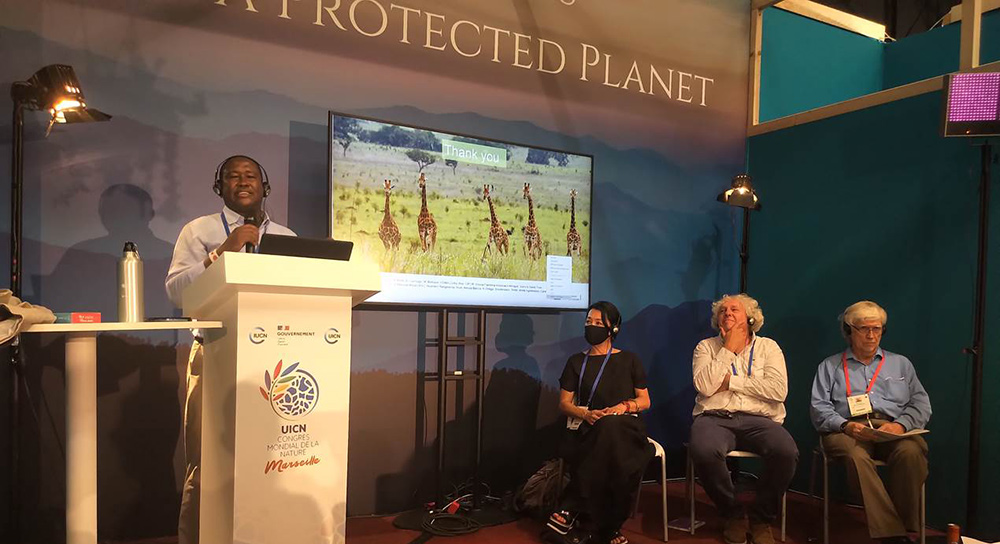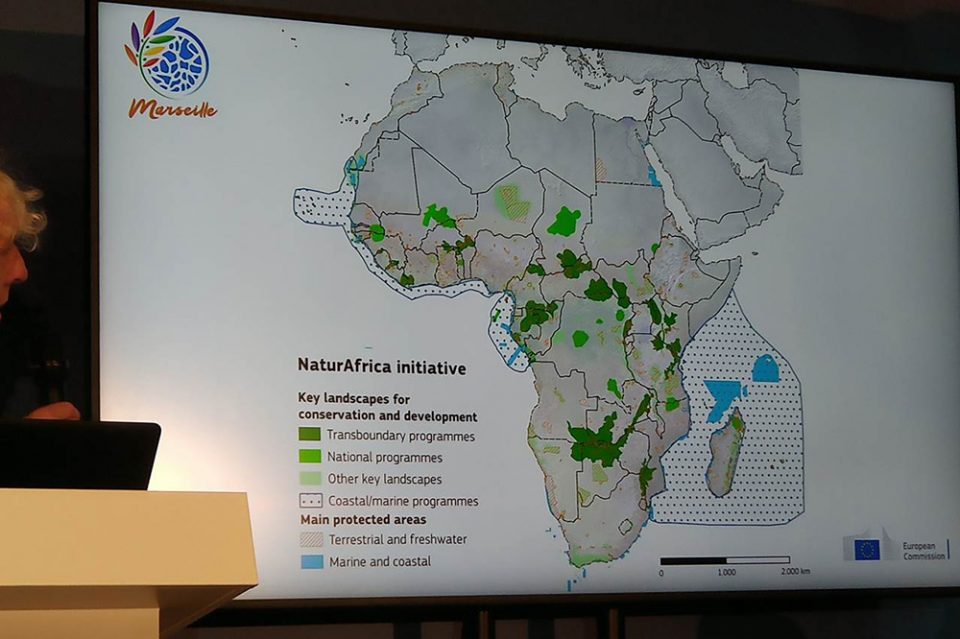By Mordecai Ogada
Following this extravagant declaration by Mayaux, the CEO of the NRT, Tom Lalampaa, barely containing his joy, took to the podium and gushed that “NaturAfrica will be welcomed by all Africans.” Only the irrational excitement brought on by Massa’s praises can cause a mere NGO director to purport to speak for the 1.3 billion inhabitants of the world’s second largest continent. Kwenda huko! Get out of here! We can see through the scheme!
In the first photo above, you can see the EU’s Philippe Mayaux presenting the audacious grand plan. He expressly stated that they are going to use the “Northern Rangelands Trust model” which has served them well thus far. I’ve been saying for the last 5 years that NRT is a model for colonialism and some invertebrates here have been breaking wind in consternation at my disrespect for their cult. The financiers have now said that it is a pilot for their planned acquisition of Africa’s natural heritage. What say you now? Who’s in charge of the plantation? Do the naïve majority now understand the violence in northern Kenya? Do the naïve majority now understand why foreign special forces are training armed personnel (outside our state security organs) to guard the so-called conservancies?

Tom Lalampaa, CEO of the NRT
On the map presented by Mayeux, you can see the takeover plan (the dark green areas); Tsavo, Amboseli and Mkomazi in northern Tanzania is a colony of the WWF “Unganisha” programme. To the west is The Nature Conservancy colony consisting of the Maasai Mara Wildlife Conservancies Association in Kenya, and the Northern Tanzania Rangelands Initiative. The rest are the NRT colony (including the Rift Valley, which is clearly marked) and the oil fields in northern Kenya. East Africa’s entire Indian Ocean seascape is marked for acquisition; spare a thought for the Island nations therein, because they have been swallowed whole. The plan has already been implemented around the Seychelles and documented.
I will repeat this as often as necessary: the biggest threat to the rights and sovereignty of African peoples in the 21st century is not military conflict, terrorism, disease, hunger, etc. It is conservation organizations and governments that seek to dominate us through conservation. They will bring their expatriates, their militaries, and their policies. If you look at the map, the relatively “free” countries—like Nigeria, Congo, Ethiopia, Sudan, Somalia, etc.—are those where international conservation NGOs haven’t been able to get a foothold. Here in Kenya, our state agency, the Kenya Wildlife Services, is busy counting animals, not knowing that it is well on the way to becoming an irrelevant spectator in our conservation arena. If you think this is far-fetched, ask someone there why there are radioactive materials dumped by the Naro Moru gate to Mt. Kenya National Park. Or why the Kenya Forest Service is standing by without any policy position while the Rhino Ark goes about fencing Mt. Kenya Forest, a UNESCO world heritage site
As I said in the beginning, my mission, together with colleagues in Survival International, is the de-colonization of conservation in Africa and the global south. The routine violation of indigenous people’s rights, and the violence constantly meted against them, is the most visible symptom that brought this problem to our notice, but we must understand that the violence isn’t just for sport, as much as these organizations revel in it. Like 18th and 19th century colonialism, it is a commercial venture where political interests follow in its wake because it is too big to remain private. When Leopold’s Belgians massacred people in Congo, it wasn’t just for sport (although at some point it looked like that)—they were there to collect rubber and other resources. The conservation militias don’t just kill indigenous Africans for sport. They are here to protect colonies on behalf of capital interests. It is not about the wildlife—that is just the window dressing. After all, the people and the wildlife were here for thousands of years before their militias came.
As I said in the beginning, my mission, together with colleagues in Survival International, is the de-colonization of conservation in Africa and the global south. The routine violation of indigenous people’s rights, and the violence constantly meted against them, is the most visible symptom that brought this problem to our notice, but we must understand that the violence isn’t just for sport, as much as these organizations revel in it. Like 18th and 19th century colonialism, it is a commercial venture where political interests follow in its wake because it is too big to remain private. When Leopold’s Belgians massacred people in Congo, it wasn’t just for sport (although at some point it looked like that)—they were there to collect rubber and other resources. The conservation militias don’t just kill indigenous Africans for sport. They are here to protect colonies on behalf of capital interests. It is not about the wildlife—that is just the window dressing. After all, the people and the wildlife were here for thousands of years before their militias came.
Find an African who was in Marseille and ask him or her what they were doing there. If they cannot demonstrate that they spoke against this colonial project, they had better show you a lot of photos of them shopping and spending a wonderful holiday in the south of France. If they can do neither, then be sure they were in France selling or facilitating the sale of our heritage to corporate pirates.

